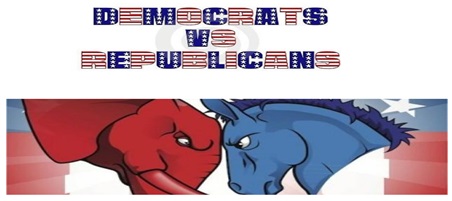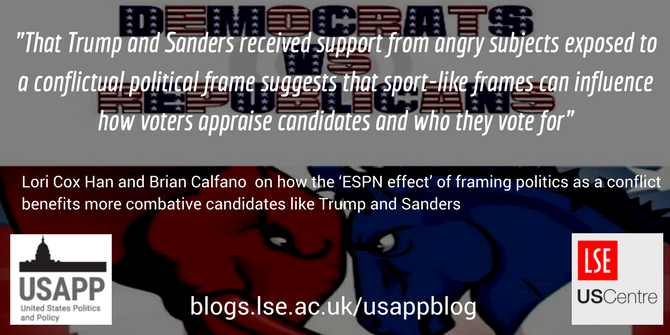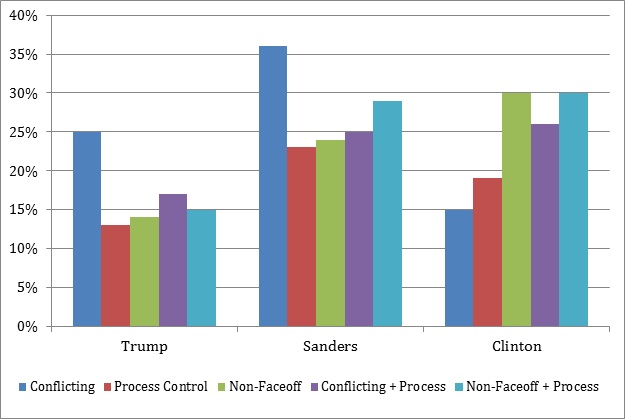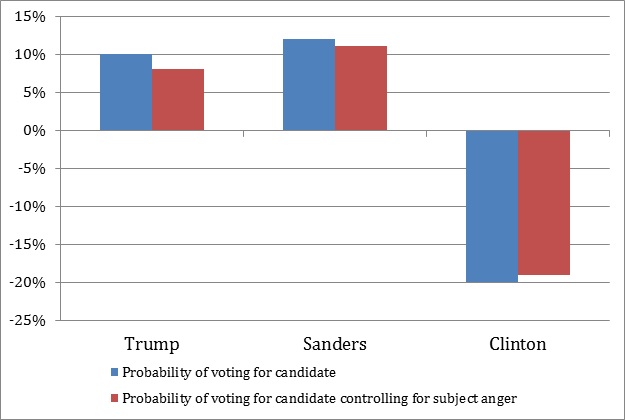
 For many observers, how we discuss politics is beginning to have more and more common with the rhetoric of sports. In the 2016 election, candidates like Donald Trump and Bernie Sanders adopted a more adversarial style. Lori Cox Han and Brian Calfano examine how a more head-to-head campaign style influences voters, finding that both Trump and Sanders benefit if campaigns are framed as a conflict which then activates voters’ anger. Hillary Clinton, by contrast, benefits when politics was framed as a less conflicting process which did not play on voters’ anger.
For many observers, how we discuss politics is beginning to have more and more common with the rhetoric of sports. In the 2016 election, candidates like Donald Trump and Bernie Sanders adopted a more adversarial style. Lori Cox Han and Brian Calfano examine how a more head-to-head campaign style influences voters, finding that both Trump and Sanders benefit if campaigns are framed as a conflict which then activates voters’ anger. Hillary Clinton, by contrast, benefits when politics was framed as a less conflicting process which did not play on voters’ anger.
Politics looks more like the zero-sum, conflict-oriented world of sports with each passing election. News media feed this politio-sport dynamic: the graphics, countdown clocks, and expert analyses resemble “big game” sports reports and an updated version of the historic fascination with “horserace” coverage.
In 2016, Donald Trump and Bernie Sanders embraced a conflictual campaign style more than their opponents, including Hillary Clinton. But does this mean that Trump and Sanders benefitted from a conflictual framing of politics while Clinton did not?
In new research, we assessed this possibility by randomly exposing a sample of 975 Americans to visuals depicting partisan conflict versus mundane political process information at the start of the 2016 presidential primary season.
The conflict frame in political media coverage reflects elements of an “ESPN effect”. But an “ESPN effect” may actually cover a variety of sport-based reactions besides conflict (e.g., enthusiasm for a team, a sense of togetherness that sports promote, etc.). This means that framing politics as conflict does not necessarily benefit combative candidates. Emotion (e.g., anger, enthusiasm, and/or anxiety) may also be part of the conflictual frame’s effect as a mediating force.
Researchers have had difficulty using words to test framing effects effectively. One way to solve the problem of language ambiguity is to use non-verbal cues, including in images. We used five combinations of Figures 1-3 in their experiment, which we refer to as the “treatment”.
Figure 1

Figure 2

Figure 3

The “Conflicting” image in Figure 1 featured “Democrats vs. Republicans” and includes the donkey and elephant symbols of the two parties in a “faceoff” posture. Figure 2 shows the “Non-Faceoff” image, which positions these same party symbols in a non-conflicting (though still somewhat aggressive) manner. These graphical depictions did not directly refer to any of the 2016 presidential candidates by name or image.
To minimize between-subject differences in political knowledge, a legislative “process” image served as baseline exposure for our control group (Figure 3). The fourth combination featured the Conflicting image plus the process control image, and the fifth combined the Non-Faceoff image with the process image.

Subjects’ mean age was 34; 55 percent were female, with 51 percent college graduates (the latter owing, in part, to the nature of Internet samples—the experiment was hosted by the survey firm Qualtrics). Subjects leaned Democratic (44 percent); 31 percent identified as Republican (23 percent as Independent). There were no significant demographic differences across the groups which were shown different images.
As seen in Figure 4, Trump’s largest amount of support (25 percent) came from those who were shown Figure 1 (the ‘Conflicting’ image). His second largest group of supportive subjects was the Conflicting and Process group (Figures 1 and 3). Trump’s lowest support percentages came from those who were only shown the Process Control image, the Non-Faceoff image (Figure 2), and the Non-Faceoff w/Process image (Figures 2 and 3), with the latter two being significantly different from the Conflicting treatment outcome.
Figure 4 – Subject Candidate Selection by Assigned Treatment

Thirty-six percent of Bernie Sanders’ support came from the Conflicting treatment (Figure 1). His second highest level of support at 29 percent is from the Non-Faceoff w/Process treatment (Figures 2 and 3). Compared to Donald Trump, Sanders does ten percent better among the Non-Faceoff image subjects. Meanwhile, Hillary Clinton’s support is virtually the inverse of Trump’s. Her highest: 30 percent from the Non-Faceoff image and 30 percent from the Non-Faceoff w/Process group. Fifteen percent of her support came from the group which was shown the Conflicting image (Figure 1).
Subjects’ anger mediated their response, but only following being shown the Conflicting image. As Figure 2 shows, the probability of Conflicting treatment subjects voting for Trump increases by 10 percentage points, which, after controlling for subject anger, drops to 8 percent. Meanwhile, the probability of Conflicting treatment subjects voting for Sanders increases by 12 percentage points, which drops to 11 after controlling for anger. Finally, the probability of Conflicting treatment subjects selecting Clinton decreases by 20 percentage points, which, after controlling for subject anger, drops to 19.
Figure 5 – Change in probability those shown Conflicting image will vote for candidate before and after controlling for anger

Trump and Sanders clearly benefit from a combination of conflictual framing and subject’s anger (partially representative of an ESPN-like influence on politics). On the other hand, Hillary Clinton benefits from framing politics as a less conflicting or factual-based process where voter anger is not activated. That Trump and Sanders received support from angry subjects exposed to a conflictual political frame suggests that sport-like frames can influence how voters appraise candidates and who they vote for. In the future, candidates will certainly continue to exploit this dynamic.
- This article is based on the paper, ‘Conflict and Candidate Selection: Game Framing Voter Choice’, in American Politics Research.
Please read our comments policy before commenting.
Note: This article gives the views of the author, and not the position of USAPP – American Politics and Policy, nor the London School of Economics, nor the authors’ institutions.
Shortened URL for this post: http://bit.ly/2zk44S0
_________________________________
About the authors
 Lori Cox Han – Chapman University
Lori Cox Han – Chapman University
Lori Cox Han is Professor of Political Science at Chapman University in Orange, California. With research and teaching interests in the presidency, women and politics, media and politics, and political leadership, she is the author of several books, including In It to Win: Electing Madam President (Bloomsbury, forthcoming), Presidents and the American Presidency (Oxford University Press); A Presidency Upstaged: The Public Leadership of George H.W. Bush (Texas A&M University Press); Women and U.S. Politics: The Spectrum of Leadership, 2nd ed. (Lynne Rienner); and Governing From Center Stage: White House Communication Strategies During the Television Age of Politics (Hampton Press).
 Brian Calfano – University of Cincinnati
Brian Calfano – University of Cincinnati
Brian Calfano is an Assistant Professor of Political Science at the University of Cincinnati. He conducts research on marginalized groups, political information use, religion and politics, and journalistic coverage of political events. Brian has 40 peer-reviewed journal articles to his credit, and is the co-author of God Talk: Experimenting with the Religious Causes of Public Opinion (Temple University Press, 2013), and A Matter of Discretion: The Political Behavior of Catholic Priests in the U.S. and Ireland (Rowman and Littlefield, 2017).






